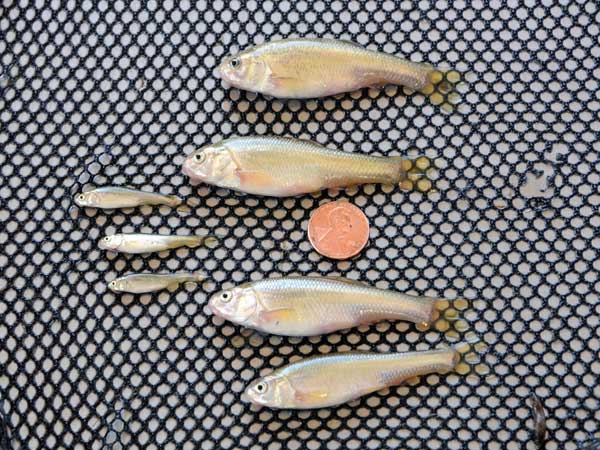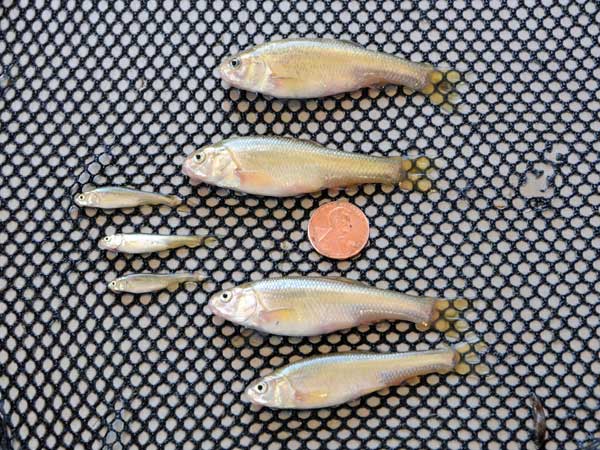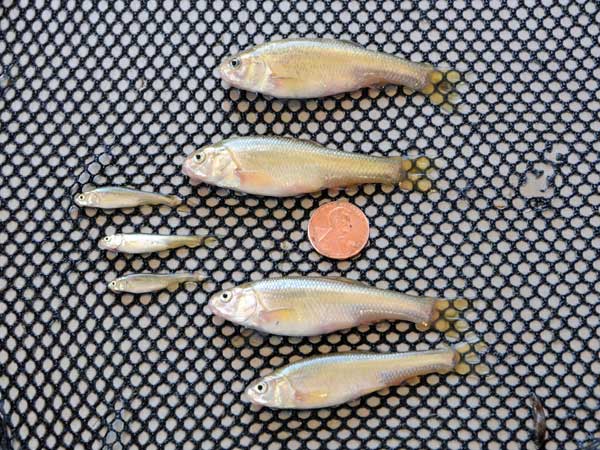By
Don C. Keller
 The smallmouth bass (Micropterus dolomieu) is a favorite of American sportsmen and has been called “Inch for inch and pound for pound the gamest fish that swims.” The world record weighed 11 pounds and 15 ounces, and was caught in 1955 at Dale Hollow Lake in Tennessee. Smallmouth bass originally ranged from northern Minnesota to Quebec, west to eastern Oklahoma and south to the Tennessee River system in Alabama. The smallmouth bass (Micropterus dolomieu) is a favorite of American sportsmen and has been called “Inch for inch and pound for pound the gamest fish that swims.” The world record weighed 11 pounds and 15 ounces, and was caught in 1955 at Dale Hollow Lake in Tennessee. Smallmouth bass originally ranged from northern Minnesota to Quebec, west to eastern Oklahoma and south to the Tennessee River system in Alabama.
Much of the common literature states that smallmouth are thought to do best in deep, cool, rocky northern or Midwestern lakes or cool water streams. Other references state that these bass prefer clear, rocky lakes that are a minimum of 25-30 feet deep and where water temperatures do not exceed 80 degrees F. A classic early study of some northern lakes with native smallmouth concluded that these bass “preferred” to stay in cooler water along deeper rocky ledges.
In reality, smallmouth were forced to compete with more dominant predators, particularly largemouth bass. The more dominant largemouth staked their claim in the prime shallower habitats and forced the smallmouth to the deeper rocky habitat. Thus, the “preferred habitat areas” of deep cool waters were probably, out of necessity, the second habitat of choice due to the competition from the largemouth. Thus, the smallmouth in order to survive took up residence in the deeper, cooler waters which are areas that were less preferred by the largemouth.
Although smallmouth are often found in cool, clear, deeper water they function quite well in warm, shallow, weedy water when other predators are sparse or absent. In the scientific literature, studies have shown that smallmouth will survive in summer water at temperatures as high as 90-95 degrees F. I personally know that smallmouth have been on the Fisheries Research Station at Auburn University in Auburn, Ala. and at the State Fish Hatchery at Marion, Ala., for more than 50 years. We have maintained smallmouth at our hatchery, AMERICAN SPORT FISH, in Montgomery, Ala., and our pond surface temperatures in July and August will reach 95 degrees F or higher. Typically, the best growth for smallmouth is around 80-85 degrees F. This is contrary to what many of us have been taught over the years. Thus, we can conclude that in most areas of the country, warm temperatures are not the limiting factor for smallmouth growth and survival.
Creating habitat:
If you are interested in creating your own smallmouth fishery in a private pond there are several key things to consider. Although it has been demonstrated that smallmouth will do quiet well in clean clay bottomed ponds, I would strongly suggest that if you have the opportunity you should provide a diverse habitat. Adding rock, from marble size to grapefruit size and larger, in piles or as riprap will provide excellent habitat for crayfish, a preferred food of smallmouth bass. Woody structure such as logs, brush, old pallets, etc., will provide hiding places for crayfish and also a place for them to feed and grow. A limited amount of marginal emergent vegetation will also provide a sanctuary for baitfish and a habitat for growing small food items for your forage fish and smallmouth.
Stocking:
 Once you have your bottom structure in place and your pond is filled, the next step is providing the forage or food source for the smallmouth. Unfortunately, there have not been any good replicated studies by Universities or Game and Fish agencies comparing forage species combinations for optimum production of smallmouth. However there have been many observations made by trained professionals who have drawn similar conclusions. One conclusion is that smallmouth generally do better with soft-rayed forage fish, such as fathead minnows, golden shiners and threadfin shad and crayfish, compared to spiny–rayed fish such as sunfish. Lake chubsuckers are also good forage for larger smallmouth bass. These forage fish should be stocked in the fall or winter and will spawn in the spring when the water reaches 60-66 degrees F. Crayfish could be stocked at the same time. A few bales of hay should be added as a food source for the crawfish. Once you have your bottom structure in place and your pond is filled, the next step is providing the forage or food source for the smallmouth. Unfortunately, there have not been any good replicated studies by Universities or Game and Fish agencies comparing forage species combinations for optimum production of smallmouth. However there have been many observations made by trained professionals who have drawn similar conclusions. One conclusion is that smallmouth generally do better with soft-rayed forage fish, such as fathead minnows, golden shiners and threadfin shad and crayfish, compared to spiny–rayed fish such as sunfish. Lake chubsuckers are also good forage for larger smallmouth bass. These forage fish should be stocked in the fall or winter and will spawn in the spring when the water reaches 60-66 degrees F. Crayfish could be stocked at the same time. A few bales of hay should be added as a food source for the crawfish.
Spiny-rayed fish such as bluegill, green sunfish, crappie, and redbreast sunfish have been reported to be detrimental to smallmouth in ponds. They reproduce heavily, overpopulate and then compete for food and space. One exception may be the redear or shellcracker. Although similar in size to the bluegill, it gets off far fewer spawns and thus does not overpopulate. Redear have been successfully used in combination with other forage fish in smallmouth ponds in Nebraska and Kansas. When smallmouth are small they will feed on insects, small crayfish and small minnows. As they get larger they will shift their diet to larger fish and thus use less energy to gain food. One study found that the large smallmouth in Dale Hollow fed mainly on threadfin shad and alewives.
After the forage has been in the pond for several months, has reproduced and built up a significant biomass of food, then the smallmouth fingerlings can be added. Stocking rates can range from 30 to 60 per acre, similar to largemouth stockings. These can be added in the early summer as 2-inch fingerlings or in the fall as 4- to 8-inch fish. One advantage of stocking the larger fingerlings in the fall is that these fish will be pellet trained, and a feeder with trout chow or a special bass ration can be used to feed the smallmouth as a supplement to their natural diet.
Do not stock largemouth bass:
 One thing is for sure; if you want a quality smallmouth pond, do not stock largemouth bass. Largemouth evolved primarily as a still or static water species and have instinctive advantages and the upper hand over smallmouth in pond or still water habitats. Largemouth will also feed heavily on smallmouth offspring. Smallmouth bass fry do not school like largemouth bass fry, but randomly disperse around the edges of the pond, becoming easy prey for small largemouth bass. Eventually, in combination with largemouth, the smallies will disappear. Smallmouth stocked alone do not cannibalize their young as aggressively as largemouth bass. One thing is for sure; if you want a quality smallmouth pond, do not stock largemouth bass. Largemouth evolved primarily as a still or static water species and have instinctive advantages and the upper hand over smallmouth in pond or still water habitats. Largemouth will also feed heavily on smallmouth offspring. Smallmouth bass fry do not school like largemouth bass fry, but randomly disperse around the edges of the pond, becoming easy prey for small largemouth bass. Eventually, in combination with largemouth, the smallies will disappear. Smallmouth stocked alone do not cannibalize their young as aggressively as largemouth bass.
To produce the optimum amount of forage, it is best to maintain some fertility program by using a good inorganic fertilizer such as PERFECT POND PLUS. Try to maintain a plankton bloom so that the visibility is in the range of 18 to 24 inches. Several studies have found that smallmouth can maintain relatively high standing crops of bass per acre. Common carrying capacities are reported to be similar to those of largemouth bass.
One reason smallmouth bass have not been stocked in private ponds in the southeast is the lack of availability of fingerlings. There are only a very few private hatcheries in the country that produce smallmouth. I personally know of only one in Kansas and one in Illinois. American Sport Fish has initiated a smallmouth bass fingerling production program to provide both 2-inch and advanced smallmouth fingerlings for pond owners.
So, if you have several ponds on your property and want to try something a little different, consider setting up a smallmouth bass pond. For sure you will have something that will give you a lot of joy and entertainment and that your neighbor will undoubtedly envy.
|


